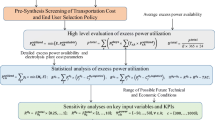Abstract
Increasing energy demand, rising import dependency and the European move towards alternative energy sources have a large influence on future energy transport systems. Volatile renewable energy sources are difficult to predict and should be able to provide for the consumer demand anytime. The latter needs the security of a large supply and availability which - combined with a fluctuating production - requires short, medium and long term storage concepts. These requirements cannot be fulfilled by the existing systems in sufficient quantities due to scarce capacities and limited flexibility, but the convergence of electricity and gas supply systems can provide the solution. Electrochemical technologies modeled as energy storages are currently in the middle of intensive political and technical discussions and under new research focus. Hydrogen as a chemical energy carrier is treated as a flagship project for the utilization of unused renewable energy production capacities. As a best option it is capable of fulfilling the requirements and can play an important role in future energy systems. This paper illustrates different aspects and consequences of hydrogen in large gas pipeline systems. Factors influencing the existing technical equipment indicate advantages and challenges for a conservative changeover to a regenerative energy supply infrastructure.
Access this chapter
Tax calculation will be finalised at checkout
Purchases are for personal use only
Preview
Unable to display preview. Download preview PDF.
Similar content being viewed by others
References
Sterner, M., Jentsch, M., Holzhammer, U.: Energiewirtschaftliche und ökologische Bewertung eines Windgas-Angebotes, Kassel, Germany (2011)
DVGW, DVGW-Arbeitsblatt G 262: Nutzung von Gasen aus regenerativen Quellen in der öffentlichen Gasversorgung, Bonn, Germany (2010)
EnWG – Energiewirtschaftsgesetz, Gesetz über die Elektrizitäts- und Gasversorgung (2011)
GasNZV – Gasnetzzugangsverordnung, Verordnung über den Zugang zu Gasversorgungsnetzen (2010)
EEG - Erneuerbares-Energien-Gesetz (2012)
Li, B., Müller-Kirchenbauer, J.: Overall simulation of German and European natural gas transmission systems. In: Hou, M.Z., Xie, H., Yoon, J.S. (eds.) Underground Storage of CO2 and Energy, pp. 305–310. CRC Press, Boca Raton (2010)
Li, B.: Simulation and capacity calculation in real German and European interconnected gas transport systems. Dissertation Technical University of Clausthal, Germany (2012)
NEP Gas, Netzentwicklungsplan Gas – Entwurf der deutschen Fernleitungsnetzbetreiber, Berlin, Germany (2012)
Tabkhi, F., Azzaro-Pantel, C., Pibouleau, L., Domenech, S.: A mathematical framework for modelling and evaluating natural gas pipeline networks under hydrogen injection, Toulouse, France (2008)
DVGW, DVGW-Arbeitsblatt G 486: Realgasfaktoren und Kompressibilitätszahlen von Erdgasen, Eschborn, Germany (1992)
Tzimas, E., Filiou, C., Peteves, S.D., Veyret, J.B.: Hydrogen Storage: State-of-the-Art and Future Perspective. Institute for Energy, Petten, The Netherlands (2003)
Wenske, M.: Stand Elektrolyse und zukünftige Entwicklung. Presentation of ENERTAG AG, Gut Dauderthal, Germany (2010)
Hüttenrauch, J., Müller-Syring, G.: Zumischung von Wasserstoff zum Erdgas. DVGW energie|wasser-praxis 10, Bonn, Germany (2010)
Schouten, J., Michels, J., Janssen-van Rosmalen, R.: Effect of H2-injection on the thermodynamic and transportation properties of natural gas. International Journal of Hydrogen Energy 29(1), 1173–1180 (2004)
DVGW, DVGW-Arbeitsblatt G 260: Gasbeschaffenheit, Bonn, Germany (2008)
Jordan, T.: Hysafe Chapter 3: Material Consideration when working with Hydrogen (2007)
Castello, P., Tzimas, E., Moretto, P., Peteves, S.: Techno-economic assessment of hydrogen transmission & distribution systems in Europe in the medium and long term. Report EUR 21586, Petten, The Netherlands (2005)
DIN EN 10208-2, Stahlrohre für Rohrleitungen für brennbare Medien - Technische Lieferbedingungen – Teil 2: Rohre der Anforderungsklasse B (2009)
Hardie, D., Charles, E., Lopez, A.: Hydrogen embrittlement of high strength pipeline steels. Corrosion Science 48(12), 4378–4385 (2006)
Capelle, J., Gilgert, J., Pluvinage, G.: Hydrogen Effect on Fatigue and Fracture of Pipe Steels. Ecole Nationale d’Ingénieurs de Metz, Metz, France (2009)
Alliat, I.: To what extent can existing pipelines accommodate hydrogen? - Presentation of NATURALHY project results, Groningen, Netherlands (2009)
Liwacom Informationstechnik GmbH & SIMONE Research Group, SIMONE SOFTWARE – Gleichungen und Methoden, Essen, Germany (2004)
Wang, J., Huang, Z., Tang, C., Miao, H., Wang, X.: Numerical study of the effect of hydrogen addition on methane-air mixtures combustion. State Key Laboratory of Multiphase Flow on Power Engineering, Xi’an Jiatong University, Xi’an, China (2008)
Hu, E., Huang, Z., He, J., Jin, C., Zheng, J.: Experimental and numerical study on laminar burning characteristics of premixed methane-hydrogen-air flames. International Journal of Hydrogen Energy, State Key Laboratory of Multiphase Flow on Power Engineering (2009)
Jassin, F.: Flammenrückschlag durch verbrennungsinduziertes Wirbelaufplatzen. Dissertation Technical University of Munich, Germany (2003)
Foh, S., Novil, M., Rockar, E., Randolph, P.: Underground Hydrogen Storage Final Report. Institute of Gas Technology, Chicago, USA (1979)
Pöppl, H.: Flexibler Prozess-Gaschromatograph für die neuen Anforderungen an Gasanalysegeräte. gwf-Gas|Erdgas, Oldenburg Energieverlag, Munich, Germany (2011)
DIN 51624, Kraftstoffe für Fahrzeuge – Erdgas – Anforderungen und Prüfverfahren. Beuth Verlag GmbH, Berlin, Germany (2008)
Author information
Authors and Affiliations
Editor information
Editors and Affiliations
Rights and permissions
Copyright information
© 2013 Springer-Verlag Berlin Heidelberg
About this paper
Cite this paper
von der Grün, G.T.M., Hotopp, S., Müller-Kirchenbauer, J. (2013). Transport and Usage of Hydrogen via Natural Gas Pipeline Systems. In: Hou, M., Xie, H., Were, P. (eds) Clean Energy Systems in the Subsurface: Production, Storage and Conversion. Springer Series in Geomechanics and Geoengineering. Springer, Berlin, Heidelberg. https://doi.org/10.1007/978-3-642-37849-2_33
Download citation
DOI: https://doi.org/10.1007/978-3-642-37849-2_33
Publisher Name: Springer, Berlin, Heidelberg
Print ISBN: 978-3-642-37848-5
Online ISBN: 978-3-642-37849-2
eBook Packages: EngineeringEngineering (R0)




